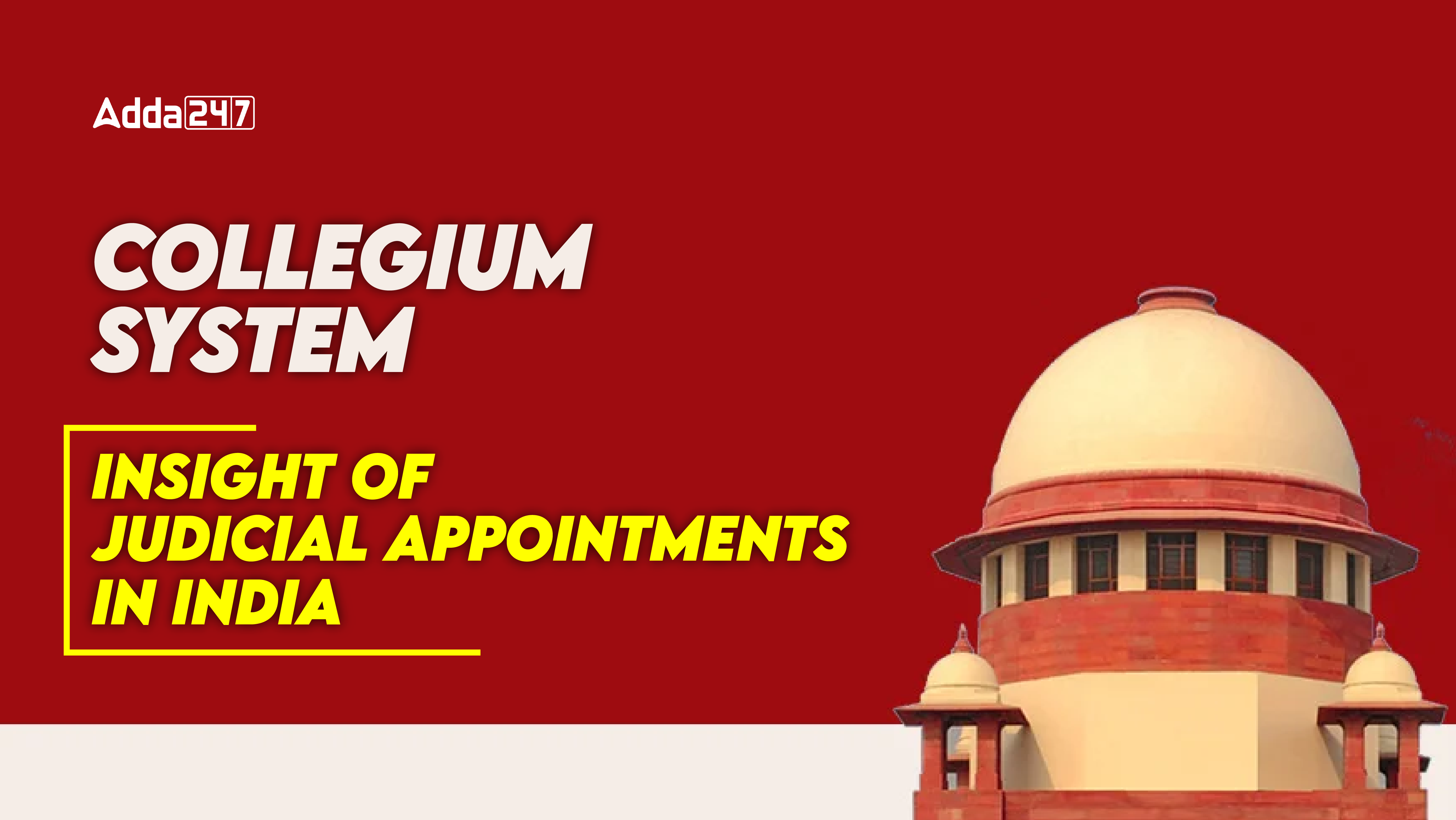Table of Contents
India uses the Collegium System to elect and transfer judges for the Supreme Court and High Courts. It evolved through judicial interpretation, rather than having the Constitution as its foundation. The appointment and transfer of judges are recommended by the Chief Justice of India (CJI) and the four senior-most Supreme Court judges under the current collegium system. Whereas, the Chief Justice of the court and the two most senior judges serve as the leaders of a High Court Collegium.
Collegium System
The appointment and transfer of judges to the SC and HCs is done through the collegium system. Only the collegium system is used to appoint judges to the higher judiciary, and the government cannot act until the collegium has selected judges.
Supreme Court Collegium: A five-member body that comprises the four senior-most justices of the court at the time, as well as the current Chief Justice of India (CJI) for the Supreme Court.
High Court Collegium: The Chief Justice and the two other senior-most judges of the High Court head the collegium.
Only names approved for appointment by the Chief Justice of India (CJI) and the SC collegium are forwarded to the government by a collegium of the High Court. If a lawyer is to be promoted to the position of judge in an HC or the SC, the government’s involvement in this entire process is restricted to requesting that the Intelligence Bureau (IB) conduct an investigation.
If the collegium selects the same candidates again, the government must appoint them even if it may disagree with the choices and ask for more information. The SC’s rulings have shaped the collegium system, which has no legal foundation in either the Constitution or a particular law passed by Parliament.
Collegium System Evolution
Article 124(2) of the Indian Constitution states that the President of India appoints each Supreme Court judge after consulting with as many High Court and Supreme Court justices as the President may see appropriate. However, because of the judgment from the Apex court, the real procedure has undergone several modifications.
First Judges Case (1981): Union of India v. S P Gupta The President of India has the last say on appointments, and he does not have to follow the opinions of the judges he consults, according to a seven-judge Constitution Bench ruling. “Consultation is not concurrence,” it was intended to say.
Second Judges Case, 1993: Union of India v. Supreme Court Advocates-on-Record Association, A Constitution Bench consisting of nine judges overturned the ruling in the SP Gupta case and established the “Collegium System,” a unique process for the selection and rotation of judges in the higher judiciary.
The CJI was granted dominance in matters about appointments and transfers, and it was decided that the phrase “consultation” would not decrease the CJI’s primary role in judicial appointments.
The executive cannot have a say in this matter because it is a matter inside the judicial family, making the role of the Chief Justice of India (CJI) important. (Indian Constitution, Article 50: Judiciary and Executive Powers Separation)
Third Judges Case (1998): In 1998, the 1993 ruling was upheld with a few minor changes in response to a presidential reference made by Article 143 of the Constitution. It was decided that the chief justice of India and his four senior colleagues known as the Collegium should make recommendations on appointments and other matters rather than the previous two.
A 1993 and 1998 judgments establish that the Chief Justice of the Supreme Court should be appointed as Chief Justice of India.
Fourth Judges Case (2015): In 2015, the Supreme Court heard a challenge to the constitutionality of the NJAC Act of 2014 and the Ninety-Ninth Constitutional Amendment. The NJAC was declared unconstitutional and invalid by a constitutional court of five judges, who ruled by a majority of 4:1 that it compromised the judiciary’s independence.
What are the Judicial Appointments Procedures?
The collegium system is used to appoint judges to the judiciary, and the government cannot act until the collegium has selected judges.
Chief Justice of India:
Chief Justice of India (CJI) and other Supreme Court judges are appointed by the President of India. For the CJI, the former CJI suggests his replacement. Since the 1970s supersession issue, seniority has been the sole criterion that is followed in practice.
Supreme Court judges:
The Chief Justice of India (CJI) is the one who makes the recommendation for the other SC judges. Together with the senior-most judge of the court from the High Court that the suggested person is a member of, the CJI consults with the remaining members of the Collegium. The written feedback from those they consult must be included in the file. The Law Minister receives the advice from the Collegium and sends it to the Prime Minister so that the President is advised.
High Court Judges:
The appointment of Chief Justices follows the principle of selection of Chief Justices who are not citizens of the respective States. The decision of promotion is made by the Collegium. The CJI and the two senior-most justices make up the Collegium that recommends candidates for the High Court. The Chief Minister receives the recommendation and suggests to the Governor that the Union Law Minister be contacted with the plan.
Reasons in Support of the Collegium System
- Confidentiality in Judicial Appointments: It is maintained confidential within the four walls of the building to ensure the institution runs well.
- The public is not aware of the how and when of a collegium’s meetings or the decision-making process that goes on behind closed doors as there is no formal secretariat involved.
- Article 50 of the Constitution states that the State shall take action to keep the judiciary and executive branches apart in the public services of the State. It guarantees that the theory of separation of powers is regulated.
- It guarantees the independence of the judiciary and permits judges to carry out their duties fearlessly and free from outside influence or intervention.
Reasons Against the Collegium System
- Claims of nepotism and favoritism: There is a lot of room for nepotism and favoritism because the Collegium does not establish any standards when choosing candidates for the Supreme Court judge seat. It could result in selecting the wrong candidate while ignoring the most suitable one.
- Abuse of Power: Three organs, functioning semi-independently, prevent any one organ from becoming overly powerful by acting as a check and balance. The Judiciary is granted enormous power by the Collegium to nominate judges, and abuse of authority may occur.
- Lack of transparency: The Collegium system causes the court system to be opaque, which is extremely unfavorable to the nation’s ability to regulate law and order.
- Unfair representation of minority and backward communities: According to data from the Union Law Ministry, 424 (79%) of the 537 High Court appointments made between 2018 and 2022 came from the general category (upper caste), 57 (11%) from Other Backward Castes (OBCs), 15 (2.8%) from Scheduled Castes (SCs), and 7 (1.3%) from Scheduled Tribes (STs).
- The government chooses judges for the Supreme Court and higher courts only on the recommendation of the SC collegium, hence there is no provision for reserving of seats for members of minority groups to ensure social diversity.
- Problem of Social variety: Over the past thirty years, the collegium system has not addressed the Supreme Court’s original plan to solve the problem of social variety in the upper judiciary.
- Judge Vacancies: Of the 1,114 judges authorized to serve in India’s 25 High courts, only 782 are now in active service, leaving 332 judge positions unfilled.
- Underrepresentation of women: Merely 107 judges, constituting 13% of the total HC judiciary, are female. Out of the 33 justices now sitting on the Supreme Court, four are women.
What actions have been made to enhance the judge appointment process?
99th Act of 2014, Amendment to the Constitution: It stipulated that the collegium system of judge nomination would be replaced by the National Judicial Commission (NJAC). But because it violated the judiciary’s independence, the Constitutional bench overturned it.
Memorandum of Procedure (MoP): The MoP is a set of guidelines that govern the appointment of justices to the high courts and the Supreme Court. The government and the courts collaborated to draft this document. On June 30, 1999, a MoP was framed by the Union administration. The present Ministry of Peace outlines the specific process for appointing judges to the Supreme Court and other high courts.
It says that the Collegium, which consists of the Chief Justice of India and the four most senior Supreme Court judges, must recommend all appointments of judges to the court. After that, the federal government receives this advice. The prime minister, who is to advise the President, will receive it from the law minister.
What steps may be taken going ahead to simplify the appointment process for judges in India?
Restructuring the MOP: There should be changes made to the current MoP. To maintain checks and balances, this may entail including representatives from the executive and judicial branches in the decision-making process on the appointment of judges.
Extending the requirements for eligibility: It should incorporate additional standards for judging candidates’ appropriateness and merit in addition to those outlined in the Constitution. All qualified applicants may be invited in full to submit an application in the required manner for the available judiciary position.
Increasing diversity: Fair representation for women in judicial appointments should be given. Transparency should be increased by keeping a list of applicants whom the collegium members individually submitted, nominated, or otherwise considered.
Written exchanges of viewpoints are possible among the collegium. Minutes should be used to record and document collegium proceedings.
Recommendations made by the Law Commission of India: judges to High Courts and the Supreme Court should be appointed and chosen on an equal basis by the judiciary and the administrative branch. The retirement age for Supreme Court judges should be raised to 68 years, and judges of the High Court should have an age limit of 65 years.
Three sources are considered: For the appointment of Supreme Court judges under Article 124(3). Nevertheless, not a single eminent jurist has been appointed in the last fifty years. Less than six judges have been appointed from the Bar as well. Appointing sufficiently deserving individuals from these sources was advised.
Check more polity articles



 Attorney General of India UPSC Notes (Ar...
Attorney General of India UPSC Notes (Ar...
 Election Laws in India UPSC Notes
Election Laws in India UPSC Notes
 Indian Parliamentary Forums UPSC Notes
Indian Parliamentary Forums UPSC Notes
